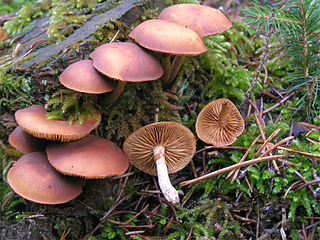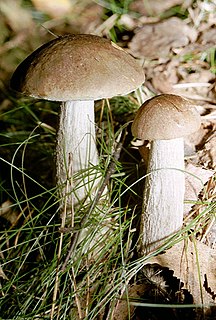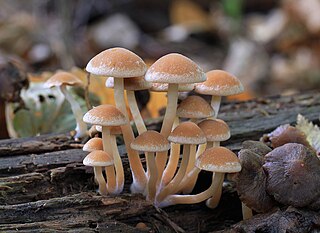
The fungal order Agaricales, also known as gilled mushrooms or euagarics, contains some of the most familiar types of mushrooms. The order has 33 extant families, 413 genera, and over 13000 described species, along with six extinct genera known only from the fossil record. They range from the ubiquitous common mushroom to the deadly destroying angel and the hallucinogenic fly agaric to the bioluminescent jack-o-lantern mushroom.

Psilocybe cyanescens is a species of potent psychedelic mushroom. The main compounds responsible for its psychedelic effects are psilocybin and psilocin. It belongs to the family Hymenogastraceae. A formal description of the species was published by Elsie Wakefield in 1946 in the Transactions of the British Mycological Society, based on a specimen she had recently collected at Kew Gardens. She had begun collecting the species as early as 1910. The mushroom is not generally regarded as being physically dangerous to adults. Since all the psychoactive compounds in P. cyanescens are water-soluble, the fruiting bodies can be rendered non-psychoactive through parboiling, allowing their culinary use. However, since most people find them overly bitter and they are too small to have great nutritive value, this is not frequently done.

Galerina is a genus of small brown-spore saprobic mushrooms, with over 300 species found throughout the world, from the far north to remote Macquarie Island in the Southern Ocean. Species are typically small and hygrophanous, with a slender and brittle stem. They are often found growing on wood, and when on the ground have a preference for mossy habitats. This group is most noted for toxic species which are occasionally confused with hallucinogenic species of Psilocybe.

Leccinum scabrum, commonly known as the rough-stemmed bolete, scaber stalk, and birch bolete, is an edible mushroom in the family Boletaceae, and was formerly classified as Boletus scaber. The birch bolete is widespread in Europe, in the Himalayas in Asia, and elsewhere in the Northern Hemisphere, occurring only in mycorrhizal association with birch trees. It fruits from June to October. This mushroom is also becoming increasingly common in Australia and New Zealand where it is likely introduced.

The Psathyrellaceae are a family of dark-spored agarics that generally have rather soft, fragile fruiting bodies, and are characterized by black, dark brown, rarely reddish, or even pastel-colored spore prints. About 50% of species produce fruiting bodies that dissolve into ink-like ooze when the spores are mature via autodigestion. Prior to phylogenetic research based upon DNA comparisons, most of the species that autodigested were classified as Coprinaceae, which contained all of the inky-cap mushrooms. However, the type species of Coprinus, Coprinus comatus, and a few other species, were found to be more closely related to Agaricaceae. The former genus Coprinus was split between two families, and the name "Coprinaceae" became a synonym of Agaricaceae in its 21st-century phylogenetic redefinition. Note that in the 19th and early 20th centuries the family name Agaricaceae had far broader application, while in the late 20th century it had a narrower application. The family name Psathyrellaceae is based on the former Coprinaceae subfamily name Psathyrelloideae. The type genus Psathyrella consists of species that produce fruiting bodies which do not liquify via autodigestion. Psathyrella remained a polyphyletic genus until it was split into several genera including 3 new ones in 2015. Lacrymaria is another genus that does not autodigest its fruiting bodies. It is characterized by rough basidiospores and lamellar edges that exude beads of clear liquid when in prime condition, hence the Latin reference, lacryma (tears).

Psathyrella candolleana is mushroom in the family Psathyrellaceae. It is commonly found on lawns or pastures in Europe and North America. In 2014, it was reported from Iraq. The coloring varies between white and golden brown. The cap measures 3–8 cm (1.2–3.1 in) in diameter, and is initially conical, later becoming rounded and finally with upturned margins in maturity. The cap margin is irregular and radially asymmetrical—a defining characteristic of this species. The spore print is purple-brown, while spores are smooth and elliptical, measuring 6.5–8 by 4–5 µm. The specific epithet candolleana honors French botanist Augustin Pyramus de Candolle.

Psilocybe cyanofibrillosa also known as Rhododendron Psilocybe and Blue-Haired Psilocybe is a psilocybin mushroom of the Agaricales family having psilocybin and psilocin as main active compounds. First documented in 1980 in the Pacific Northwest, it is relatively uncommon and can be distinguished from other closely related species by its smaller spores and forking cheilocystidia.
Psilocybe cyanescens also has forking cheilocystidia, but less often than Psilocybe cyanofibrillosa. Psilocybe cyanofibrillosa is also distinguished from Psilocybe cyanescens by an absence of pleurocystidia.
The name of this species refers to the fibrils on the Stipe (mycology) that turn bluish in age, or when handled.

Gymnopilus braendlei is a species of agaric fungus that contains the hallucinogens psilocybin and psilocin. It was originally collected by mycologist Charles Horton Peck as Flammula braendlei in the District of Columbia near Washington (1902).
Psilocybe plutonia is a small psilocybin mushroom of the Strophariaceae family, believed to contain psilocybin and psilocin. It was first documented from Cuba. An older synonym is Agaricus plutonia.

Psilocybe aztecorum is a species of psilocybin mushroom in the family Hymenogastraceae. Known from Arizona, Colorado, central Mexico, India and Costa Rica, the fungus grows on decomposing woody debris and is found in mountainous areas at elevations of 2,000 to 4,000 m, typically in meadows or open, grassy conifer forests. The mushrooms have convex to bell-shaped caps 1.5–2 cm (0.6–0.8 in) in diameter, atop slender cylindrical stems that are up to 7.5 cm (3.0 in) long. The color of the caps changes with variations in hydration, ranging from dark chestnut brown to straw yellow or whitish when dry. The base of the stem is densely covered with conspicuous white rhizomorphs, a characteristic uncommon amongst Psilocybe species.

Cantharellus californicus, sometimes called the mud puppy or oak chanterelle, is a fungus native to California, United States. It is a member of the genus Cantharellus along with other popular edible chanterelles. It is generally similar in appearance to C. cibarius and C. formosus except for its large size at maturity; individual specimens larger than 1 kilogram (2.2 lb) are reported, making it the largest known species of chanterelle. Their unusual size is due in part to their capacity for indeterminate growth, making Cantharellus californicus specimens actively grow for far longer than most other mushrooms.

Psilocybe pelliculosa is a species of fungus in the family Hymenogastraceae. The fruit bodies, or mushrooms, have a conical brownish cap up to 2 cm (0.8 in) in diameter atop a slender stem up to 8 cm (3.1 in) long. It has a white partial veil that does not leave a ring on the stem. American mycologist Alexander H. Smith first described the species in 1937 as a member of the genus known today as Psathyrella; it was transferred to Psilocybe by Rolf Singer in 1958.

Psathyrella bipellis is a species of mushroom in the Psathyrellaceae family.

Psathyrella ammophila is a species of fungus in the family Psathyrellaceae and is found throughout Europe. Commonly known as the dune brittlestem, this agaric primarily grows on sand dunes near marram grass, feeding saprotrophically on the decaying roots. The season of growth is generally May to November.

Parasola auricoma is a species of agaric fungus in the family Psathyrellaceae. First described scientifically in 1886, the species is found in Europe, Japan, and North America. The mushroom was reported in February 2019 in Colombia, in the city of Bogota by the mycologist Juan Camilo Rodriguez Martinez. The small, umbrella-shaped fruit bodies (mushrooms) of the fungus grow in grass or woodchips and are short-lived, usually collapsing with age in a few hours. The caps are up to 6 cm (2.4 in) wide, initially elliptical before flattening out, and colored reddish-brown to greyish, depending on their age and hydration. They are pleated with radial grooves extending from the center to the edge of the cap. The slender, whitish stems are up to 12 cm (4.7 in) long and a few millimeters thick. Microscopically, P. auricoma is characterized by the presence of setae in its cap cuticle. This characteristic, in addition to the relatively large, ellipsoid spores can be used to distinguish it from other morphologically similar Parasola species.

Psilocybe allenii is a species of agaric fungus in the family Hymenogastraceae. Described as new to science in 2012, it is named after John W. Allen, who provided the type collection. It is found in the northwestern North America from Los Angeles, California to British Columbia, Canada, most commonly within 10 miles (16 km) of the Pacific coast.

Psathyrella piluliformis is a species of agaric fungus in the family Psathyrellaceae. It produces fruit bodies (mushrooms) with broadly convex caps measuring 2–5 cm in diameter. The caps are chestnut to reddish brown, the color fading in age and with dry weather. The closely spaced Gills have an adnate attachment to the stipe. They are initially tan until the spores mature, when the gills turn dark brown. Fragments of the partial veil may remain on the cap margin, and as a wispy band of hairs on the stipe. Fruiting occurs in clusters at the base of hardwood stumps.

Psathyrella spadicea, commonly known as the chestnut brittlestem, is a species of agaric fungus in the family Psathyrellaceae. The fungus was originally described by German mycologist Jacob Christian Schäffer in 1783 as Agaricus spadiceus. Rolf Singer transferred it to the genus Psathyrella in 1951, in which it is classified in the section Spadiceae. The mushroom is edible.
Djon djon (djon-djon) is the common name for a type of edible black mushroom often found in northern Haiti and used as a delicacy in some Haitian dishes, such as Diri ak djon djon. The name is thought not to refer to a single species of mushroom, but is rather thought to be a colloquial name for several taxonomically distinct species. The mushrooms can be found on the marketplace in some western stores, though reportedly they are sold at high prices — Gene Yetter of the New Jersey Mycological Association and New York Mycological Society reported that he found them being sold dried in New York for around $1 USD for a quarter of an ounce.

























